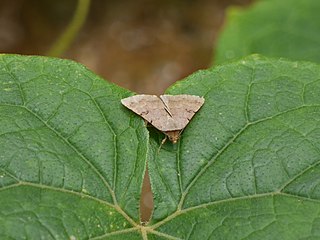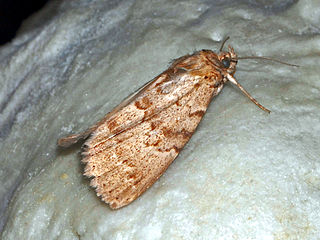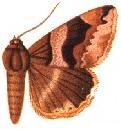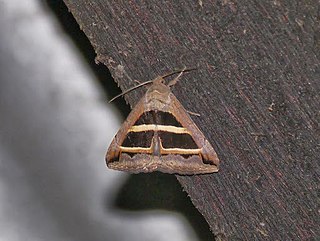Tarachephia is a monotypic moth genus of the family Noctuidae erected by George Hampson in 1926. Its only species, Tarachephia hueberi, was first described by Nikolay Grigoryevich Erschoff in 1874. It is found in Turkestan. It is found in Syria, Iraq, Iran, the Transcaspian Region, Uzbekistan, Turkmenistan, Afghanistan and Israel.
Zethes insularis is a species of moth in the family Erebidae first described by Jules Pierre Rambur in 1833. The species is found in the warmer parts of the Mediterranean area: Armenia and the Caucasus, Iraq, south-western Iran, Lebanon, Israel, Syria and Jordan.
Antarchaea erubescens is a species of moth of the family Noctuidae first described by Andreas Bang-Haas in 1910. It is found from Morocco to the Arabian Peninsula southern Iran and Afghanistan.

Plecoptera reflexa is a species of moth of the family Noctuidae first described by Achille Guenée in 1852. It is mainly found in India, but its range extends west as far as the central and northern parts of the coastal plains of Israel.
Plecoptera inquinata is a species of moth of the family Noctuidae first described by Julius Lederer in 1857. It is found in Turkey, Azerbaijan, Iran, Lebanon and Israel.

Apopestes spectrum is a species of moth in the family Erebidae first described by Eugenius Johann Christoph Esper in 1787.
Autophila limbata is a moth of the family Noctuidae first described by Otto Staudinger in 1871. It is found in southern France, southern Italy, the Iberian Peninsula, Greece, the Crimea, the Near East, Iran, Transcaucasia and Turkmenistan.

Lygephila lusoria is a moth of the family Erebidae. The species was first described by Carl Linnaeus in his 1758 10th edition of Systema Naturae. It is found in southern Europe, the Near East and Middle East, European south-eastern Russia, the Caucasus, Turkey and Israel.

Crypsotidia maculifera is a species of moth in the family Erebidae first described by Otto Staudinger in 1898. The species is found in Burkina Faso, Cape Verde, Egypt, Ethiopia, Ghana, Kenya, Malawi, Mauritania, Niger, Nigeria, Senegal, Sudan, Cyprus and Israel.
Dysgonia rogenhoferi is a moth of the family Noctuidae first described by Otto Bohatsch in 1880. It is found in Lebanon, Israel, Iraq, Arabia, Turkmenistan, northern Iran, Uzbekistan, the European part of southern Russia, Azerbaijan and Pakistan.

Dysgonia torrida, the jigsaw, is a moth of the family Erebidae. The species was first described by Achille Guenée in 1852. It is found from the tropical and subtropical areas of Africa to Spain, southern Italy, Greece, Syria, Israel, Iran, Uzbekistan towards India, Sri Lanka and Myanmar.

Grammodes bifasciata is a moth of the family Erebidae first described by Vincenzo Petagna in 1787. It is found in Madagascar, eastern Africa, North Africa and other parts of the Mediterranean Basin, including south of France and Israel.
Pericyma squalens is a moth of the family Noctuidae first described by Julius Lederer in 1855. It is found in south-eastern Turkey, Iran, Iraq, Afghanistan, Turkmenistan, Kuwait, Saudi Arabia, Egypt, Lebanon, Israel and Jordan.
Rhabdophera arefacta is a species of moth in the family Erebidae first described by Swinhoe in 1884. The species is found in India, Pakistan, Egypt, Israel, Jordan and Iraq.
Heteropalpia acrosticta is a species of moth in the family Erebidae first described by Rudolf Püngeler in 1904. The species is found from the western parts of the Sahara to Israel, Jordan, Egypt and most of the Arabian Peninsula.
Heteropalpia profesta is a moth of the family Noctuidae first described by Hugo Theodor Christoph in 1887. It is found in the Near East, the Middle East, Iraq, Iran, Afghanistan, Transcaucasia, Turkmenistan and the Arabian Peninsula.
Tytroca dispar is a moth of the family Noctuidae first described by Rudolf Püngeler in 1904. It is found in semi-deserts and deserts from the Sahara, the Arabian Peninsula, Israel, Jordan and the Sinai.
Tytroca leucoptera is a moth of the family Noctuidae first described by George Hampson in 1896. It is found in the Arabian Peninsula and all deserts of North Africa.
Gnamptonyx innexa is a species of moth in the family Erebidae first described by Francis Walker in 1858. The species is found from Morocco to the Arabian Peninsula, Israel, Iran, Afghanistan, Pakistan and western India.

Chazaria incarnata is a species of moth of the family Noctuidae. It is found on the Canary Islands and on the Iberian Peninsula, east to Italy, Serbia, Romania, Bulgaria, North Macedonia and Greece. Further east it is found to southern and eastern Russia in the north and Turkey, the Dead Sea region of Israel and Iran.




